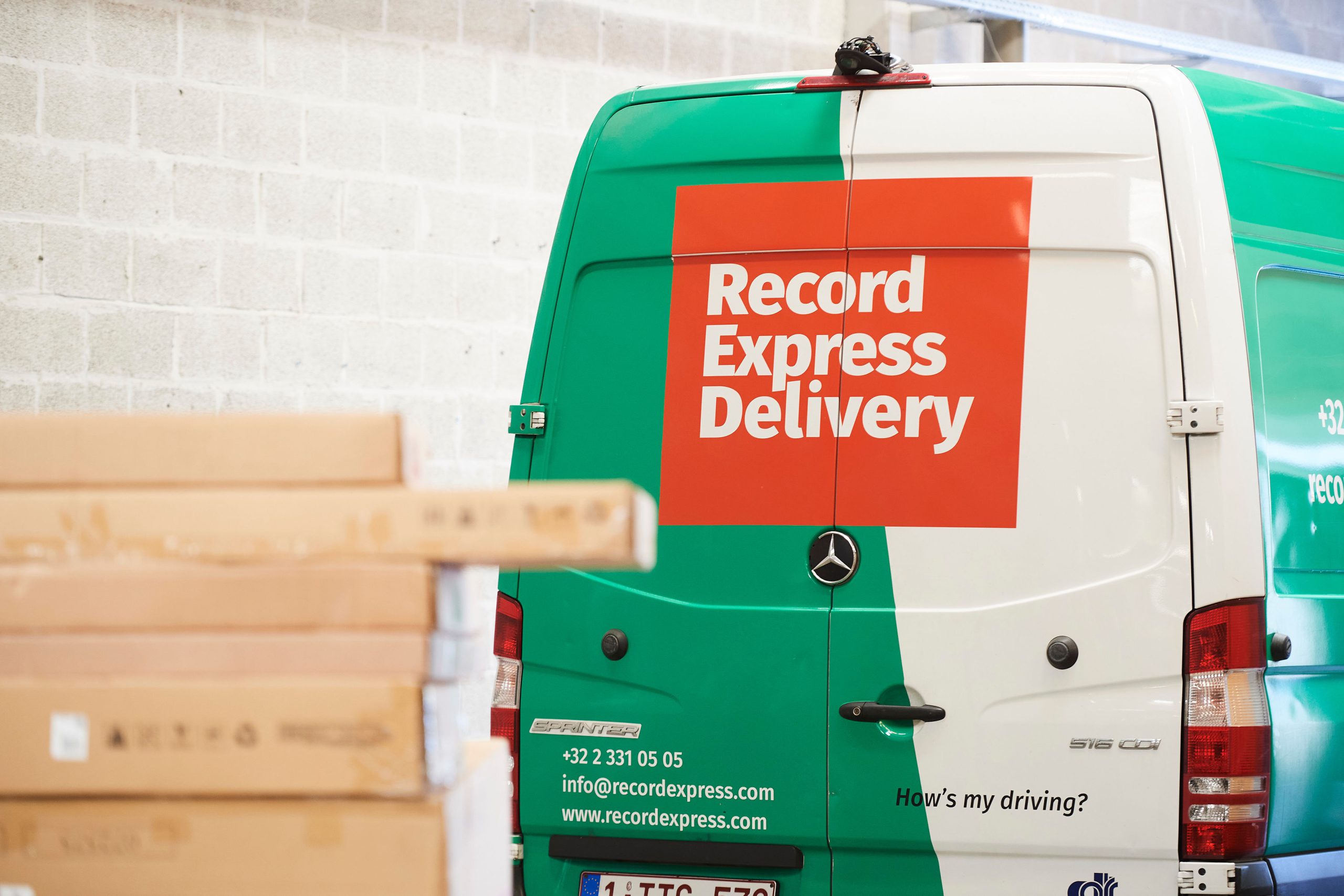Warehouse-to-Site Logistics in Belgium: Workflows & Best Practices
Best practices for warehouse-to-site logistics in Belgium. SEND PARCELHome / Our Business Areas / Industry /

Warehouse-to-site logistics is the controlled flow of goods from a warehouse or hub to a job site, store, or plant at the exact time they’re needed. In Belgium, tight urban streets, low-emission zones, and multilingual job sites make coordination the real challenge. The fix is a clear workflow—book time windows, stage by sequence, load with damage-proofing, run LEZ-compliant routes, and capture photo proof on arrival. Record Express delivers this with own-fleet control, construction-friendly scheduling, and KPI reporting built for Belgian projects.
Related guides:
Furniture Delivery in Belgium ·
Coordinating Deliveries to Construction Sites ·
Last-Mile for Industrial Deliveries
Why does warehouse-to-site logistics matter in Belgium?
Direct answer: It aligns inventory with site schedules so crews, installers, or engineers have the right materials at the right time—without saturating the site with stock.
The Belgian context adds complexity: historic city centres restrict access, low-emission zones (LEZ) limit vehicle choices, and many projects combine French, Dutch, and English-speaking contractors. Busy facilities and construction sites can accept deliveries only in short windows, often early morning or night, which forces precision. When this flow is not orchestrated, you see idle crews, re-handling, and damage. When it is orchestrated, trucks arrive, unload directly to point of use, and leave without blocking neighbours or incurring fines. For retailers rolling out store refits, or manufacturers launching new lines, this coordination is often the single biggest lever to protect timelines and cash. Warehouse-to-site is therefore less about raw transport and more about synchronising people, access, and materials under one plan.
What are the core workflow stages?
Direct answer: Plan → Pick → Stage → Load → Transport → Arrive → Verify. Each stage has owners, documents, and risks that must be controlled.
The plan defines site constraints, contact names, and time windows. Picking builds job-ready kits. Staging groups those kits by installation sequence. Loading locks down loads with padding and strapping. Transport respects LEZ rules and route timing. Arrival follows an access protocol. Verification closes the loop with photos, signatures, and variance notes so finance and project teams can reconcile quickly.
| Workflow stage | Goal | Typical documents | Risk if skipped | Best-practice control |
|---|---|---|---|---|
| Plan | Map constraints and contacts | Site plan, RAMS, permits | Missed windows, fines | Single source of truth and shared schedule |
| Pick | Build kits accurately | Pick list, BOM | Wrong items, shortages | Scan items and second-person check |
| Stage | Group by sequence | Staging labels | Re-handling on site | Colour-coded bays per phase |
| Load | Protect and secure | Load sheet | Damage or shift | Blankets, edge bars, straps, photos |
| Transport | Meet slot & LEZ rules | Route plan | Delay or access refusal | EV/Euro 6 vans and geofenced ETAs |
| Arrive | Access without disruption | Gate pass | Queues, neighbour complaints | Book parking and use quiet hours |
| Verify | Close out quickly | ePOD, photos | Disputes and slow invoicing | Photo proof and over/short report |
How do you schedule deliveries so work keeps moving?
Direct answer: Work backwards from the task sequence on site, deliver just-in-time for each activity, and keep a flexible fallback slot.
If installers start at 07:00, the relevant materials should arrive between 06:00 and 06:30, not the day before. Buffer the first delivery of the day, but compress later ones by using consolidation points near the site. In Belgian cities this usually means staging in a suburb outside the LEZ and shuttling in smaller compliant vehicles. Share the delivery plan with the site lead in their preferred language and agree an escalation path—phone call first, then SMS—if anything slips. Always carry a fallback slot for weather or crane delays. The goal is to keep on-site stock light: enough to work the next one or two tasks, no more. That reduces theft risk, clutter, and re-handling. Belgian holiday blackouts and local market days also change access patterns, so the calendar must be reviewed weekly. Include union rules for loading hours and local noise windows near hospitals and schools.
How do you prevent damage when moving heavy or odd-shaped goods?
Direct answer: Protect edges, separate surfaces, and immobilise the load; then slow down for the last 10 metres inside the building.
Use reusable blankets, foam corners, and anti-slip mats. Pack tall items vertically against rails and use straps at multiple heights. Cap loose parts in bags taped to the parent item. For machinery, block and brace sensitive components and fix moving parts. Photograph items at departure and at placement on site to prove condition. Avoid stacking unless packaging is designed for it. The fastest way to create damage is to rush the final ten metres—through doors, lifts, and corridors—so allocate the right crew and tools for that last-mile inside the building.
| Item type | Typical risk | Packaging / handling control |
|---|---|---|
| Laminate panels | Corner crush | Hard corners + blankets; keep vertical |
| Glass or mirrors | Surface scratches | Soft sleeves; never slide |
| Machines on castors | Rollaway shift | Wheel locks + straps |
| Painted steel | Scuffing | Non-abrasive separators |
| Long profiles | Bend | Edge bars and centre supports |
What documentation makes warehouse-to-site predictable?
Direct answer: Use one digital trail from order to placement—ASN, pick list, load sheet, route plan, gate pass, and ePOD—so every step adds proof without heavy admin.
Barcode or QR labels tie cartons and loose items to the job. Drivers carry the contact of the site lead and a fallback contact for gate security. On arrival, the ePOD records actual time, photos, and any variance—over, short, or damage—so finance can invoice the same day. That speed matters on projects where multiple suppliers and trades are inter-dependent. The goal is clarity: short inputs at each step that build a complete picture anyone can understand, even when teams change shift or language.
How do LEZ rules and sustainability change the plan?
Direct answer: Use EV or Euro-6 vans inside LEZ zones, compress routes to reduce empty miles, and replace single-use packaging with reusable protection.
LEZ rules in Brussels, Antwerp, and Ghent restrict older diesel vehicles, and many clients ask for carbon-aware transport. The practical response is to route smaller EV or Euro-6 vans into city cores and keep larger trucks at suburban hubs. Dense routing and micro-staging minimise idling. Reusable blankets and crates cut single-use packaging. A simple emissions table—tonnes delivered versus km and vehicle type—lets you report a clear CO₂ intensity per project. When sustainability is embedded in the workflow rather than added as an afterthought, it reduces cost as well as footprint.
What are the most common failure modes—and how do you avoid them?
Direct answer: The same issues repeat across projects: unclear access, missed time slots, incomplete picks, poor load security, and no signatory. Solve them with pre-survey photos, daily confirmations, scan-verified picking, strapping standards, and a named on-site contact who can sign ePOD.
If any one of these is shaky, the rest of the plan will wobble. Adding a lightweight “go/no-go” checklist 24 hours before delivery catches most problems before wheels turn. Finally, keep a recovery playbook—nearby storage if a slot is lost, a second driver for heavy placements, and a rapid-repair contact for minor damage—so delays never cascade across trades.
Which KPIs prove the operation is under control?
Direct answer: Track on-time arrival, first-attempt success, touches per item, damage rate, ePOD cycle time, and an overall “deliveries completed per working day.”
Align these KPIs across client, contractor, and carrier to prevent blame loops and accelerate decisions. In Belgium, include an LEZ compliance rate to demonstrate city-centre readiness. For executive dashboards, convert metrics into a traffic-light view: green when all majors are above target, amber for risk, red for stop-and-fix.
| KPI | Target | Why it matters |
|---|---|---|
| On-time to slot | ≥ 98% | Keeps cranes and crews productive |
| First-attempt success | ≥ 95% | Avoids re-delivery cost and congestion |
| Damage rate | ≤ 0.5% | Protects budget and relationships |
| Touches per item | ≤ 3 | Fewer touches mean fewer defects |
| ePOD closed | Same day | Enables same-day invoicing |
How does Record Express run warehouse-to-site in practice?
Direct answer: Own-fleet control, construction-grade planning, and data-rich proof keep timing and condition non-negotiable.
Jobs are pre-surveyed, staged by installation sequence, and moved by crews who know how to handle heavy or fragile items inside buildings. Vehicles carry blankets, edge bars, straps, and anti-slip mats as standard. Every stop is confirmed the day before with a named driver and plate number. On arrival we manage neighbours and safety, move items directly to the point of use, and capture photos before and after placement. When something changes—the slot, the gate, the weather—we reroute quickly because we control the fleet and the data. That’s why major retailers, office fit-out teams, and manufacturers use us for deliveries where timing and condition are critical.
Talk to Record Express about micro-staging, LEZ-ready vans, and ePOD reporting tailored to Belgian projects.
FAQ
Do you support night or weekend slots for city-centre projects?
Yes. We routinely deliver early morning, night, and weekend slots to avoid congestion, reduce noise complaints, and meet strict access windows.
Can you stage materials outside the LEZ and shuttle them in?
Yes. We use suburban micro-hubs to consolidate loads and then move final legs with EV or Euro-6 vans inside LEZ zones.
How do you prove condition on arrival?
ePOD with photo proof at pickup and at point-of-use placement. Variances are logged instantly so finance can reconcile the same day.
Sources & Further Reading
- Record Express — Deliveries to Construction Sites
- Record Express — Eco-Friendly Last-Mile
- Brussels Capital Region — Low Emission Zone

Record Express was awarded a 59/100 score by EcoVadis, the global leader in sustainability ratings.